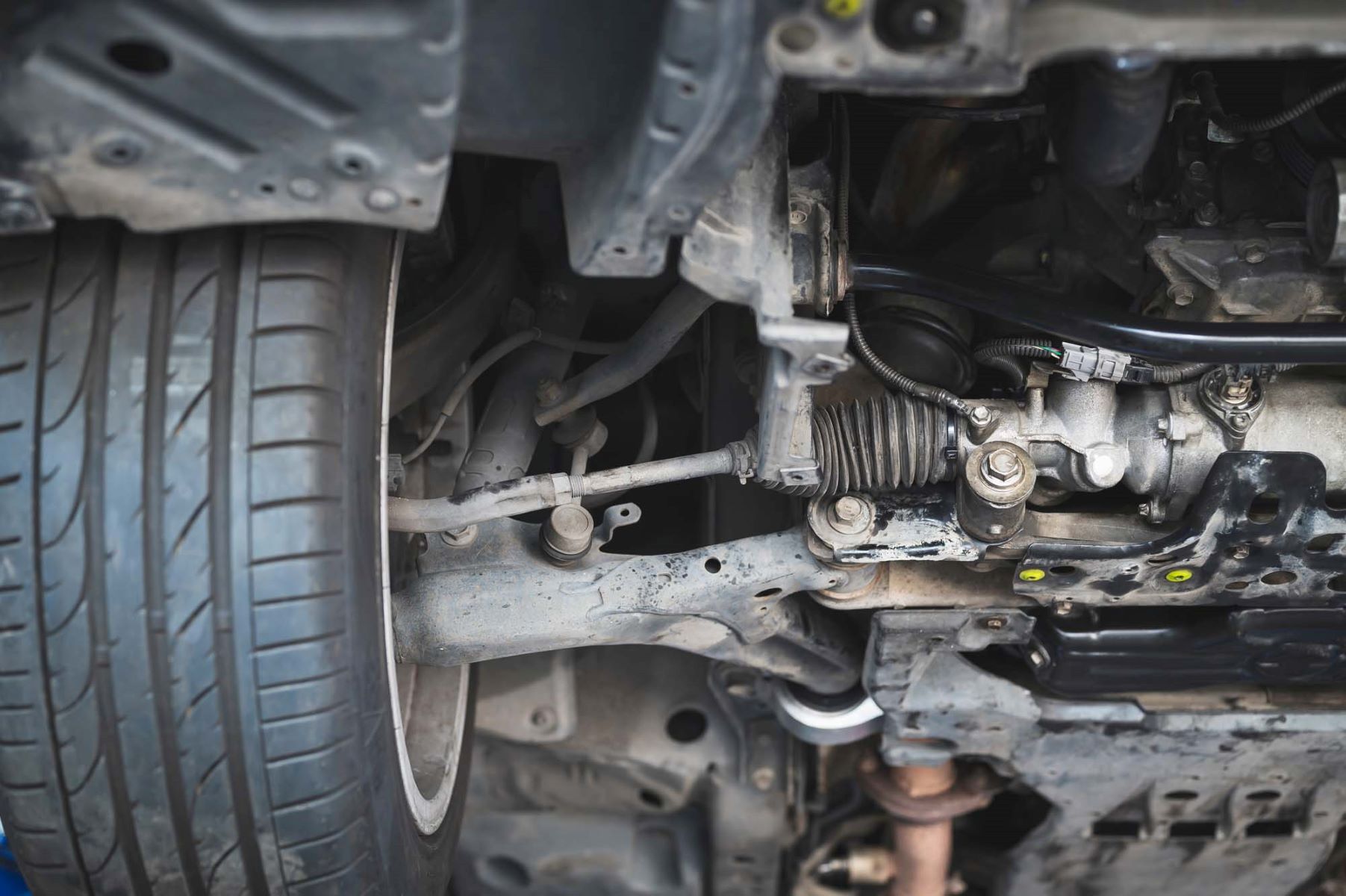Home>Automotive>Is Your Rack And Pinion Shot? Here’s How To Diagnose The Problem!


Automotive
Is Your Rack And Pinion Shot? Here’s How To Diagnose The Problem!
Published: January 25, 2024
Learn how to diagnose a potential rack and pinion issue in your vehicle with our comprehensive guide. Get expert tips and insights on automotive troubleshooting. Discover the signs of a failing rack and pinion system now!
(Many of the links in this article redirect to a specific reviewed product. Your purchase of these products through affiliate links helps to generate commission for Regretless.com, at no extra cost. Learn more)
Table of Contents
Signs of a Worn Rack and Pinion
The rack and pinion system is a critical component of a vehicle's steering mechanism, responsible for converting the rotational motion of the steering wheel into the linear motion required to turn the wheels. Over time, this vital system can wear down, leading to a range of noticeable signs that indicate potential issues. Recognizing these signs early on can help prevent further damage and ensure the safety and efficiency of your vehicle.
Read more: How To Rack 8 Ball
1. Unusual Noise
One of the most common indicators of a worn rack and pinion system is the presence of unusual noises while steering. If you notice a persistent clunking, knocking, or popping sound when turning the steering wheel, it could be a clear indication of a problem with the rack and pinion assembly. These noises may originate from worn-out or damaged internal components, such as the rack mounts, inner tie rods, or bushings.
2. Steering Wheel Play
Excessive play or looseness in the steering wheel is another sign of potential rack and pinion wear. When the steering wheel feels loose and lacks responsiveness, it may suggest issues with the rack and pinion gears or the tie rod ends. This can compromise the vehicle's handling and responsiveness, posing a safety risk on the road.
3. Fluid Leaks
Leaking power steering fluid is a telltale sign of a failing rack and pinion system. The presence of puddles or drips of power steering fluid beneath the front of the vehicle indicates potential leaks from the rack and pinion assembly. These leaks can stem from damaged seals, cracked housing, or worn-out components, and should be addressed promptly to prevent a loss of steering control.
4. Uneven Tire Wear
A worn rack and pinion system can lead to uneven tire wear, particularly on the front tires. If you observe excessive or uneven tread wear on the front tires, it may be attributed to steering irregularities caused by a compromised rack and pinion assembly. Addressing the underlying issue can help preserve the longevity of your tires and maintain optimal vehicle performance.
5. Steering Wheel Vibration
Vibrations or feedback felt through the steering wheel, especially during turns or at varying speeds, can indicate potential problems with the rack and pinion system. These vibrations may stem from worn-out components, misaligned steering linkage, or issues with the power steering system, highlighting the need for a thorough inspection and potential rack and pinion replacement.
Recognizing these signs of a worn rack and pinion system is crucial for maintaining the safety, performance, and longevity of your vehicle. By addressing these indicators in a timely manner, you can ensure a smooth and responsive steering experience while preventing potential hazards on the road.
Common Symptoms of a Failing Rack and Pinion
A failing rack and pinion system can manifest a range of common symptoms that serve as red flags for potential issues. Understanding these prevalent indicators is crucial for promptly addressing any underlying problems and ensuring the safety and performance of your vehicle.
-
Steering Wheel Instability: A noticeable symptom of a failing rack and pinion is the instability or unpredictability of the steering wheel. If you experience sudden jerking or wandering of the steering wheel, especially at higher speeds or while navigating uneven road surfaces, it could indicate wear or damage within the rack and pinion assembly. This instability can compromise the vehicle's handling and responsiveness, posing a safety risk to the driver and passengers.
-
Difficulty Steering: Difficulty in steering, particularly during low-speed maneuvers or when initiating turns, is a common symptom of rack and pinion issues. If you find it increasingly challenging to turn the steering wheel, accompanied by stiffness or resistance, it may signal potential wear or binding within the rack and pinion system. This can lead to a cumbersome driving experience and hinder the driver's ability to navigate effectively.
-
Power Steering Fluid Contamination: Contaminated power steering fluid is often an indication of internal rack and pinion problems. If you observe discolored or murky power steering fluid during routine checks, it may suggest the presence of metal shavings or debris within the system, signifying wear and potential damage to the rack and pinion components. Addressing this issue promptly is essential to prevent further deterioration of the steering mechanism.
-
Steering Wheel Drift: A failing rack and pinion can result in steering wheel drift, where the vehicle tends to veer to one side without driver input. This drift, often noticeable on straight roads, can stem from internal wear or misalignment within the rack and pinion assembly, leading to compromised steering control and stability. Addressing this symptom is crucial to maintain safe and predictable vehicle handling.
-
Burning Smell: In some cases, a burning smell emanating from the front of the vehicle, particularly near the steering column, can indicate potential rack and pinion issues. This odor may result from excessive friction and heat generated within the worn or damaged components of the rack and pinion system, necessitating immediate attention to prevent further damage and potential safety hazards.
Recognizing these common symptoms of a failing rack and pinion is essential for proactive maintenance and timely repairs. By addressing these indicators promptly, vehicle owners can ensure optimal steering performance, safety, and overall driving experience.
Steps to Diagnose a Faulty Rack and Pinion
Diagnosing a faulty rack and pinion system is crucial for maintaining the safety and performance of your vehicle. By following a systematic approach, you can effectively identify potential issues and take the necessary steps to address them promptly. Here are the comprehensive steps to diagnose a faulty rack and pinion:
-
Visual Inspection: Begin by conducting a visual inspection of the rack and pinion assembly. Check for any signs of power steering fluid leaks around the rack housing, inner tie rods, or boots. Additionally, inspect the condition of the boots for tears, cracks, or signs of deterioration. Any visible leaks or damage can indicate potential issues with the rack and pinion system.
-
Steering Wheel Play: With the vehicle parked, start the engine and turn the steering wheel from lock to lock while paying close attention to any excessive play or looseness. If there is noticeable play before the wheels begin to turn, it could indicate wear or damage within the rack and pinion assembly, particularly the internal gears or tie rod ends.
-
Listening for Unusual Noise: While the vehicle is stationary or in motion, listen for any unusual noises when turning the steering wheel. Clunking, knocking, or popping sounds may suggest internal wear or loose components within the rack and pinion system. These noises can help pinpoint potential areas of concern within the assembly.
-
Road Test: Take the vehicle for a road test to assess its steering responsiveness and stability. Pay attention to any steering wheel vibrations, wandering, or drifting tendencies, especially when driving straight on a level road. Additionally, observe the vehicle's handling during turns and note any stiffness or difficulty in steering, which can indicate potential rack and pinion issues.
-
Fluid Analysis: Check the power steering fluid for any discoloration, contamination, or metal shavings. Discolored or murky fluid may indicate internal wear or damage within the rack and pinion assembly, necessitating further inspection and potential component replacement.
-
Professional Inspection: If any of the above steps reveal potential issues or if you are uncertain about the diagnosis, it is advisable to seek a professional inspection by a qualified mechanic or technician. They can perform a more comprehensive assessment using specialized tools and diagnostic equipment to accurately identify any rack and pinion problems.
By following these systematic steps, you can effectively diagnose a faulty rack and pinion system, enabling timely repairs and maintenance to ensure the safety, performance, and longevity of your vehicle's steering mechanism. Prompt attention to potential issues can help prevent further damage and ensure a smooth and responsive driving experience.
Conclusion
In conclusion, the rack and pinion system plays a pivotal role in the steering mechanism of vehicles, translating the driver's input from the steering wheel into precise wheel movements. Recognizing the signs of a worn or failing rack and pinion is essential for maintaining the safety, performance, and longevity of a vehicle. From unusual noises and steering wheel play to fluid leaks and uneven tire wear, these indicators serve as crucial red flags that warrant immediate attention.
By being vigilant and proactive in addressing potential rack and pinion issues, vehicle owners can prevent further damage and ensure a smooth and responsive driving experience. Moreover, understanding the common symptoms of a failing rack and pinion, such as steering wheel instability, difficulty steering, power steering fluid contamination, steering wheel drift, and burning smells, empowers individuals to take timely action and seek professional assistance when needed.
Diagnosing a faulty rack and pinion system involves a systematic approach, including visual inspections, assessing steering wheel play, listening for unusual noises, conducting road tests, analyzing power steering fluid, and seeking professional inspections when uncertainties arise. By following these comprehensive steps, vehicle owners can accurately identify potential issues and facilitate necessary repairs and maintenance.
Ultimately, maintaining a healthy rack and pinion system is not only crucial for the vehicle's functionality but also for the safety of the driver, passengers, and other road users. Addressing early signs of wear or damage within the rack and pinion assembly can prevent hazardous situations and ensure optimal steering performance, contributing to a secure and enjoyable driving experience.
In essence, staying attuned to the condition of the rack and pinion system and promptly addressing any emerging issues are fundamental practices for vehicle maintenance. By doing so, individuals can uphold the safety, efficiency, and reliability of their vehicles, ultimately enhancing the overall driving experience while promoting road safety.














